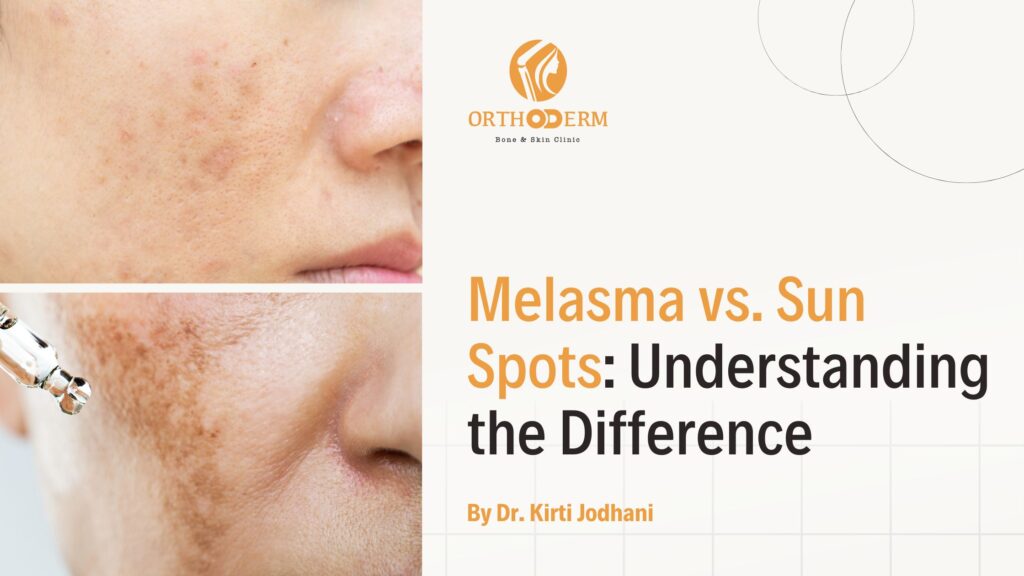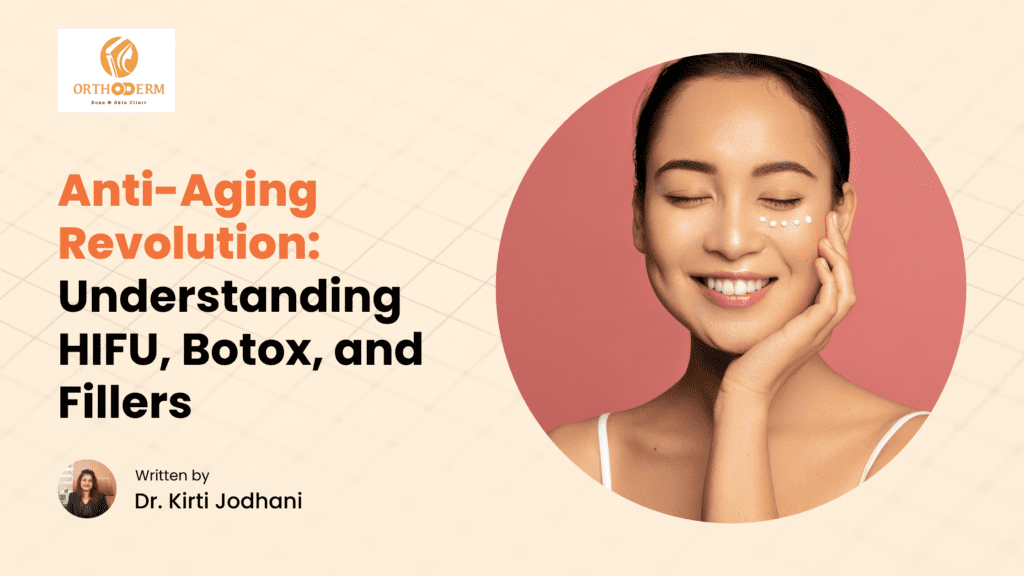Have you ever noticed uneven patches of discoloration on your face? In India, with our beautiful and diverse skin tones, these concerns are particularly common. As a dermatologist, I see patients every day who are worried about dark spots and want to achieve a clearer, more radiant complexion. Two frequent culprits behind facial pigmentation are melasma and sun spots. While they may look similar on the surface, understanding the key differences between these conditions is vital for getting the most effective treatment.
In this blog post, we’ll unveil the mysteries of melasma and sun spots, focusing specifically on how they manifest on Indian skin. We’ll explore the causes, typical locations, and the crucial distinctions that set them apart. Armed with this knowledge, you’ll be better equipped to discuss your concerns with a dermatologist and develop a personalized plan for achieving flawless skin. Let’s get started!
What is Melasma?
Melasma, sometimes referred to as “the mask of pregnancy” because it’s often triggered by hormonal changes, is a common skin condition that causes patches of irregular pigmentation. These patches typically range in color from light to dark brown, and in some cases, they can also have a grayish or bluish tinge.
While melasma can affect people of all skin tones, it’s particularly prevalent in individuals with darker complexions, like many of us here in India. The most common locations for melasma are on the face, particularly on the forehead, cheeks, bridge of the nose, and upper lip. These areas tend to receive the most sun exposure throughout the day.
The exact cause of melasma remains a bit of a mystery, but I see it frequently in patients experiencing hormonal fluctuations. Pregnancy, birth control pills, and even hormone replacement therapy can all trigger melasma. Sun exposure, however, is a major contributing factor, even if it’s not the sole cause. So next, let’s delve into the reasons why sunlight plays such a significant role in the development of melasma.
What Causes Melasma?
As I mentioned earlier, the exact cause of melasma is still being unraveled by dermatologists worldwide. It seems to be a complex interplay of several factors, with sun exposure acting as a major trigger. Here’s what we know so far:
- Sun exposure: While not the sole culprit, sun exposure is a significant player in melasma development. The ultraviolet (UV) rays in sunlight stimulate the production of melanin, the pigment that gives our skin its color. In individuals with melasma, this stimulation can become uneven, leading to the formation of patchy discolorations.
- Hormonal fluctuations: Pregnancy hormones, particularly estrogen and progesterone, are well-known triggers for melasma. This is why the condition is often nicknamed “the mask of pregnancy.” Birth control pills and hormone replacement therapy can also contribute to similar reasons.
- Genetics: Research suggests that genetics play a role in melasma susceptibility. People with a family history of the condition, especially those with darker skin tones, are more likely to develop it.
It’s important to remember that melasma isn’t caused by a single factor. It’s more like a domino effect, where sun exposure, hormonal changes, and genetics all work together to increase your risk. In the next section, we’ll explore how sunspots differ from melasma, even though they can sometimes look similar.
What are Sun Spots?
Sun spots, also known as solar lentigines, are another common cause of dark patches on the skin. Unlike melasma, however, sun spots have a much clearer culprit: sun exposure. They’re essentially the result of years of accumulated sun damage on the skin’s surface.
Sunspots typically appear as flat, brown spots that range in size from a freckle to a dime. They can develop anywhere on the body that’s regularly exposed to the sun, but they’re most commonly found on areas like the face, arms, hands, neck, and chest.
The key difference between sunspots and melasma lies in their cause. While sun exposure plays a role in both, it’s the primary driver for sun spots, whereas melasma is triggered by a combination of factors like hormones and genetics. We’ll explore these distinctions further in the next section, but for now, let’s keep diving into the world of pigmentation!
Key Differences Between Melasma and Sun Spots: Unveiling the Mystery
While both melasma and sun spots can cause those pesky dark patches on your skin, understanding the key differences between them is crucial for effective treatment. Here’s a breakdown to help you tell them apart:
Cause:
- Melasma: A multifactorial condition triggered by a combination of sun exposure, hormonal fluctuations (pregnancy, birth control pills), and genetics (more common in those with a family history).
- Sun Spots: Primarily caused by accumulated sun damage over time.
Location:
- Melasma: Typically appears on the face, particularly on areas that receive a lot of sun exposure like the forehead, cheeks, bridge of the nose, and upper lip. It often presents with a symmetrical pattern on both sides of the face.
- Sun Spots: These can develop anywhere on the body that gets regular sun exposure, but most commonly appear on the face, arms, hands, neck, and chest. Their distribution tends to be more scattered and not necessarily symmetrical.
Appearance:
- Melasma: Presents as irregular brown-to-greyish patches with blurred borders. These patches can vary in size and sometimes merge together to form larger areas of discoloration.
- Sun Spots: Typically appear as well-defined, round, or oval-shaped brown spots. Their size can range from a freckle to a dime and they usually have a more uniform color.
Fading:
- Melasma: Can be more stubborn and persistent. While some lightening may occur with sun protection, it often requires specific treatments prescribed by a dermatologist.
- Sun Spots: May fade somewhat with consistent sun protection. However, complete removal might require cosmetic procedures like laser therapy.
Remember, this is just a general guide. There can be some overlap in appearance, so consulting a dermatologist for a proper diagnosis is always recommended. In the next section, we’ll explore some treatment options for melasma, keeping in mind its prevalence in Indian skin tones.
Melasma Treatment Options in India: Unveiling a Brighter You
As a dermatologist who frequently sees patients with melasma in India, I understand the desire for clear, radiant skin. While there’s no one-size-fits-all cure for melasma, several treatment options can effectively manage and lighten the discoloration. Here’s an overview of some commonly used approaches:
Topical Creams
These are often the first line of defense. Creams containing ingredients like hydroquinone, azelaic acid, kojic acid, and tretinoin can help lighten pigmentation and even out skin tone. It’s important to note that hydroquinone may not be suitable for all skin types, particularly darker ones, due to the potential for lightening side effects. Always consult your dermatologist to determine the best cream for your individual needs.
Chemical Peels
Controlled applications of chemical solutions can help remove the top layer of skin, promoting regeneration and potentially reducing the appearance of melasma patches. However, chemical peels require careful selection and monitoring, especially for Indian skin tones, to avoid post-inflammatory hyperpigmentation (darkening after inflammation).
Laser Therapy
In some cases, laser treatments can be used to target and lighten melasma. Different laser types offer varying degrees of effectiveness, and a consultation with your dermatologist will help determine if this approach is right for you. It’s important to remember that laser therapy also requires expertise to ensure optimal results with minimal side effects on Indian skin.
Here’s a crucial point to remember: Sun protection is absolutely essential when managing melasma. Regardless of the treatment approach, consistent use of a broad-spectrum sunscreen with SPF 30 or higher is vital to prevent further darkening and promote long-term results.
In the next section, we’ll delve deeper into sun protection strategies specifically tailored for Indian skin tones, helping you achieve and maintain a healthy, glowing complexion.
Sun Protection Tips for Indian Skin: Shielding Your Beauty
Sun protection is crucial for everyone, but especially for those with darker skin tones like many of us in India. Melanin, the pigment that gives our skin its beautiful color, can also make us more susceptible to hyperpigmentation, including melasma and sun spots. Here are some key sun protection strategies to keep in mind:
Sunscreen is Your BFF
Make a broad-spectrum sunscreen with SPF 30 or higher your daily companion. Apply it generously to all exposed skin 15 minutes before heading outdoors, and reapply every two hours, or more frequently if sweating or swimming. Look for lightweight, oil-free formulas that are labeled as “non-comedogenic” to avoid clogging pores, which can be a concern for some skin types.
Don’t Forget the Often-Missed Spots
Ears, lips, the back of your neck, and the tops of your feet are all prime targets for sun damage. Be sure to extend sunscreen application to these areas as well.
Seek Shade When Possible
The sun’s rays are strongest between 10 am and 4 pm. Whenever possible, plan outdoor activities for these times or seek shade under umbrellas, trees, or canopies.
Sun-Protective Clothing is Your Ally
Wide-brimmed hats, sunglasses with UV protection, and long-sleeved, loose-fitting clothing made from breathable fabrics like cotton or linen provide additional sun protection.
Embrace the Umbrella Life
Don’t underestimate the power of an umbrella! It’s a fantastic way to provide shade and block UV rays, keeping your skin cool and protected.
Bonus Tip for Indian Skin
Natural ingredients like turmeric and licorice extracts have shown promise in lightening hyperpigmentation. While not a replacement for sun protection, these ingredients, when used in conjunction with a dermatologist-approved skincare routine, can offer additional benefits. However, it’s important to consult a dermatologist before incorporating any new products, especially if you have sensitive skin.
By following these sun protection tips and consulting with a dermatologist for personalized advice, you can effectively shield your skin from sun damage and achieve a healthy, radiant complexion. Remember, sun protection is an investment in your skin’s future, so embrace these habits and enjoy the sunshine with confidence!
Conclusion: Unveiling Clearer, More Radiant Skin
As we’ve explored, melasma and sunspots can be a concern for many in India. The good news is that by understanding the key differences between these conditions and implementing the right strategies, you can achieve clearer, more radiant skin.
Remember, sun protection is the cornerstone of preventing and managing pigmentation. Consistent use of sunscreen, along with sun-protective clothing and smart sun habits, is essential. Additionally, if you suspect you have melasma, consulting a dermatologist is crucial for proper diagnosis and a personalized treatment plan.
I hope this blog post has empowered you with valuable information about melasma and sunspots. Don’t hesitate to call us at 070020 33804 and schedule a consultation with me if you have any further questions. Until next time, take care of that beautiful skin!
Frequently Asked Questions: Melasma vs. Sun Spots
Here are some commonly asked questions I receive from patients in India about melasma and sunspots:
1. I have dark patches on my cheeks, but they’re not perfectly symmetrical. Could it still be melasma?
Melasma typically presents with symmetrical patches on the face, but there can be some variation. If you’re unsure, it’s always best to consult a dermatologist for a proper diagnosis. They can examine your skin and rule out other possibilities like sun spots or post-inflammatory hyperpigmentation.
2. I’m pregnant and noticing new dark patches on my face. Is this melasma?
Yes, hormonal changes during pregnancy are a common trigger for melasma. It’s often nicknamed “the mask of pregnancy” for this reason. If you’re concerned, consult your dermatologist. They can advise on safe and effective ways to manage melasma during pregnancy.
3. I use a lot of turmeric for my skin. Can it help with melasma?
Turmeric extract has shown promise in lightening hyperpigmentation. While it may not be a replacement for sun protection or other treatments, it could offer some benefits when used alongside a dermatologist-approved skincare routine. However, it’s important to consult your dermatologist before incorporating any new products, especially if you have sensitive skin.
4. Can I treat melasma at home with over-the-counter creams?
Some over-the-counter creams may help lighten melasma, but they may not be as effective as prescription medications or treatments recommended by a dermatologist. Consulting a dermatologist allows for a personalized approach based on the severity and specific characteristics of your melasma.
5. I’m worried about the side effects of laser treatment for melasma. Are there other options?
Laser therapy is just one approach for treating melasma. Depending on the severity and your individual case, your dermatologist may recommend topical creams, chemical peels, or a combination of therapies. It’s important to discuss all options and potential side effects with your dermatologist to determine the best course of action for you.
If you have any concerns about melasma, sun spots, or other skin conditions, don’t hesitate to call us at 070020 33804 and schedule a consultation. And if you have any questions about the information I’ve shared, feel free to leave a comment below. Let’s continue the conversation about healthy skin!



